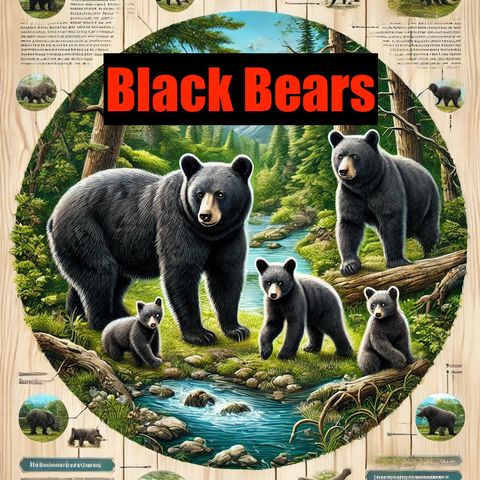Black Bears- Stewards of The Forest

Download and listen anywhere
Download your favorite episodes and enjoy them, wherever you are! Sign up or log in now to access offline listening.
Black Bears- Stewards of The Forest
This is an automatically generated transcript. Please note that complete accuracy is not guaranteed.
Description
Amidst the dense forests and rugged landscapes of North America, a remarkable creature roams, often unseen but forever etched in the tapestry of the continent's wilderness: the black bear (Ursus...
show moreBlack bear cubs are born blind, hairless, and weighing less than a pound (0.5 kg). They are entirely dependent on their mother's milk and care for survival. Cubs remain with their mother for about 18 months, learning crucial survival skills such as foraging, climbing, and avoiding predators. After this time, the cubs disperse to establish their own territories, and the mother is ready to mate again. Female black bears typically reach sexual maturity at around 3 to 5 years of age, while males mature slightly later, at 4 to 6 years. The lifespan of black bears in the wild can vary greatly depending on factors such as habitat quality, food availability, and human-related mortality, but they can live up to 30 years or more. Conservation and Human Interaction Black bears have a complex history of interaction with humans, ranging from reverence and cultural significance to persecution and conflict. In many Indigenous cultures across North America, black bears are considered sacred animals, often associated with healing, wisdom, and spiritual power. These traditional ecological knowledge systems have played a vital role in shaping the relationship between bears and people for thousands of years. However, as European colonization and settlement expanded across the continent, black bears increasingly came into conflict with human activities. They were hunted for their meat, fur, and fat, and were often seen as a threat to livestock and crops. Bounty systems and unregulated hunting led to significant declines in black bear populations in many parts of their range. In the 20th century, changing attitudes towards wildlife and the implementation of conservation measures, such as regulated hunting and habitat protection, helped to stabilize and recover many black bear populations. Today, black bears are considered a species of least concern by the International Union for Conservation of Nature (IUCN), with stable or increasing populations in most of their range. Despite this success, black bears still face ongoing challenges, primarily related to human-bear conflicts and habitat loss. As human development continues to expand into bear habitat, encounters between bears and people are becoming more frequent, often resulting in property damage, injury, or even death for both bears and humans. Managing these conflicts through education, bear-proof waste management, and land-use planning is crucial for ensuring the long-term coexistence of black bears and people. Looking to the future, the conservation of black bears will require a multifaceted approach that addresses the complex social, ecological, and economic factors that shape the relationship between bears and humans. This will involve ongoing research to better understand black bear ecology, behavior, and population dynamics, as well as the development of innovative strategies for reducing human-bear conflicts and promoting coexistence. Education and outreach will also play a critical role in fostering a greater appreciation for black bears and their place in the natural world. By teaching people about bear biology, behavior, and the importance of protecting bear habitat, we can help to build a culture of coexistence that values the presence of these magnificent animals on the landscape. Additionally, the integration of Indigenous knowledge and perspectives into black bear conservation and management will be essential for developing culturally relevant and sustainable strategies for protecting bears and their habitats. By learning from the deep ecological knowledge and cultural practices of Indigenous peoples, we can gain valuable insights into how to live alongside black bears in a way that honors their intrinsic value and ecological importance. Ultimately, the future of black bears will depend on our willingness to coexist with them and to protect the wild places they call home. By working together to address the challenges facing black bears and their habitats, we can help to ensure that these enigmatic dwellers of the forest continue to thrive for generations to come. From the misty forests of the Pacific Northwest to the hardwood groves of the Appalachian Mountains, black bears have long captured the hearts and imaginations of those who share their world. Their remarkable adaptability, resilience, and enduring presence on the landscape serve as a testament to the power and beauty of the natural world. As we face the challenges of the 21st century, it is more important than ever to recognize the value of black bears and the ecosystems they inhabit. By investing
Information
Copyright 2024 - Spreaker Inc. an iHeartMedia Company
